Part II - Foreign Taxes
Paid or Accrued
Robert uses Part II, Form 1116, to report the foreign tax paid or accrued on income from foreign sources.
Form 1116 - General limitation income. On this Form 1116, Robert enters the amount of foreign taxes paid (withheld at source), in foreign currency and in U.S. dollars, on the wages from Country X.
Form 1116 - Passive income. On this Form 1116, Robert enters the amount of foreign taxes paid, in foreign currency and in U.S. dollars, on the interest and dividend income.
Part III - Figuring
the Credit
Robert figures the amount of foreign tax credit in Part III on each Form 1116.
Form 1116 - General limitation income. On this Form 1116, Robert figures the amount of foreign tax credit allowable for the foreign taxes paid on his wages from Country X.
Line 10. He has a carryover of $200 for unused foreign taxes paid in 2001 and enters that amount on line 10. He attaches a schedule showing how he figured his $200 carryover to 2002 after carrying back the unused $350 tax paid in 2001 to the 2 preceding tax years. (This schedule is shown in
Table 4.) The unused foreign tax in 2001 and the excess limits in 1999 and 2000 are in the general limitation income category. The unused foreign tax of $200 is carried over to the general limitation income category in 2002.
Line 12. On line 12, Robert must reduce the total foreign taxes paid by the amount related to the wages he excludes as foreign earned income. To do this, he multiplies the $27,400 foreign tax he paid on his foreign wages by a fraction. The numerator of the fraction is his foreign earned income exclusion ($80,000) minus a proportionate part of his definitely related business expenses ($2,400 - $480 = $1,920). The denominator of the fraction is his total foreign wages ($100,000) minus his total definitely related business expenses ($2,400).
| $27,400
|
×
|
$80,000-$1,920 $100,000-$2,400
|
=
|
$21,920
|
|
Line 13. His total foreign taxes available for credit are $5,680 ($200 carryover from 2001 + $5,480 paid in 2002 ($27,400 - $21,920)).
Line 20. By completing the rest of Part III, Robert finds that his limit is $1,989.
Line 21. The foreign tax credit on the general limitation income is the lesser of the foreign tax available for credit, $5,680, or the limit, $1,989
Form 1116 - Passive income. Robert now figures the foreign tax credit allowable for the foreign taxes he paid on his interest and dividend income from Country X.
By completing Part III of Form 1116, he finds that the limit on his credit is $536.
The foreign tax credit is the lesser of the foreign tax paid, $500, or the limit, $536.
Part IV - Summary of
Credits From
Separate Parts III
Robert summarizes his foreign tax credits for the two types of income on Part IV of
one Form 1116. He uses the Part IV of Form 1116 - General limitation income.
Robert leaves line 32 blank because he did not participate in or cooperate with an international boycott during the tax year. The allowable foreign tax credit is $2,489 ($500 + $1,989), shown on line 33. He also enters this amount on line 45 of Form 1040.
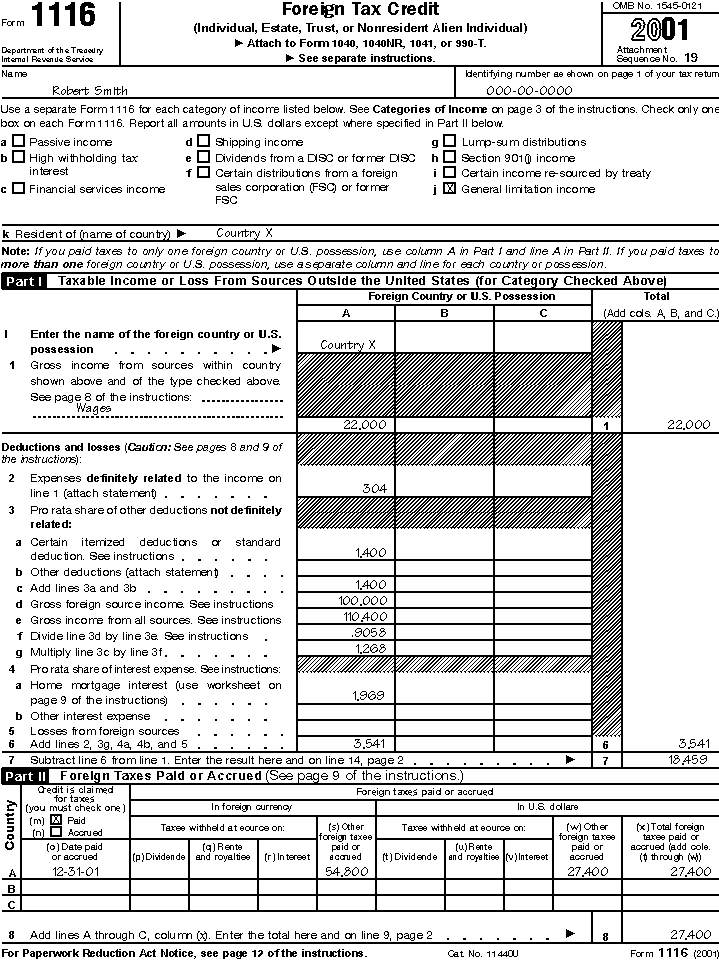 Form 1116, page 1 for Robert Smith
Form 1116, page 1 for Robert Smith
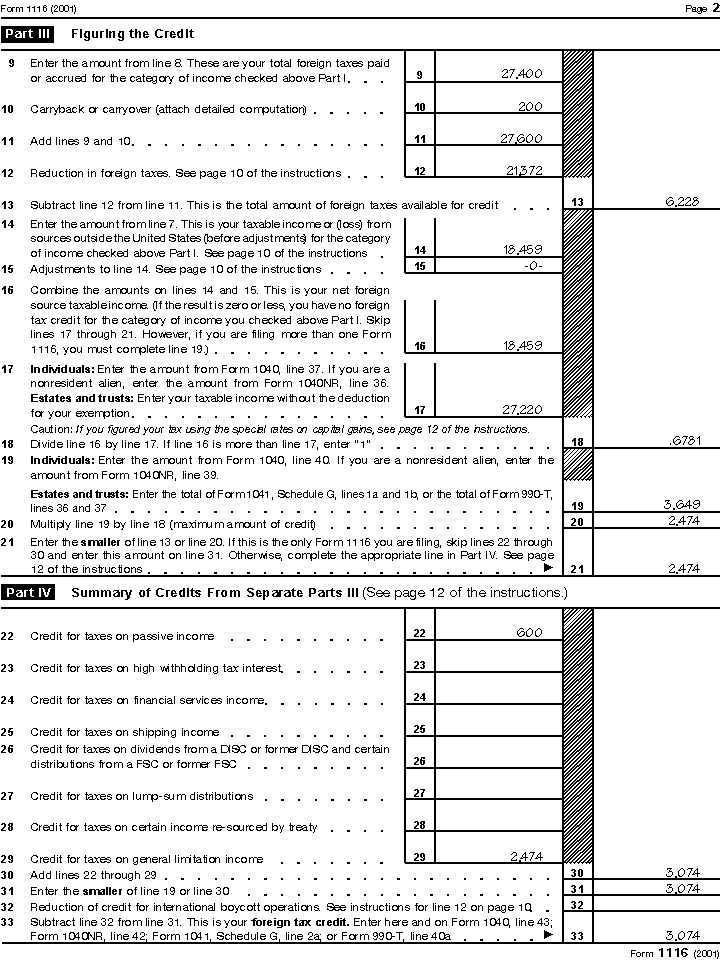 Form 1116, page 2 for Robert Smith
Form 1116, page 2 for Robert Smith
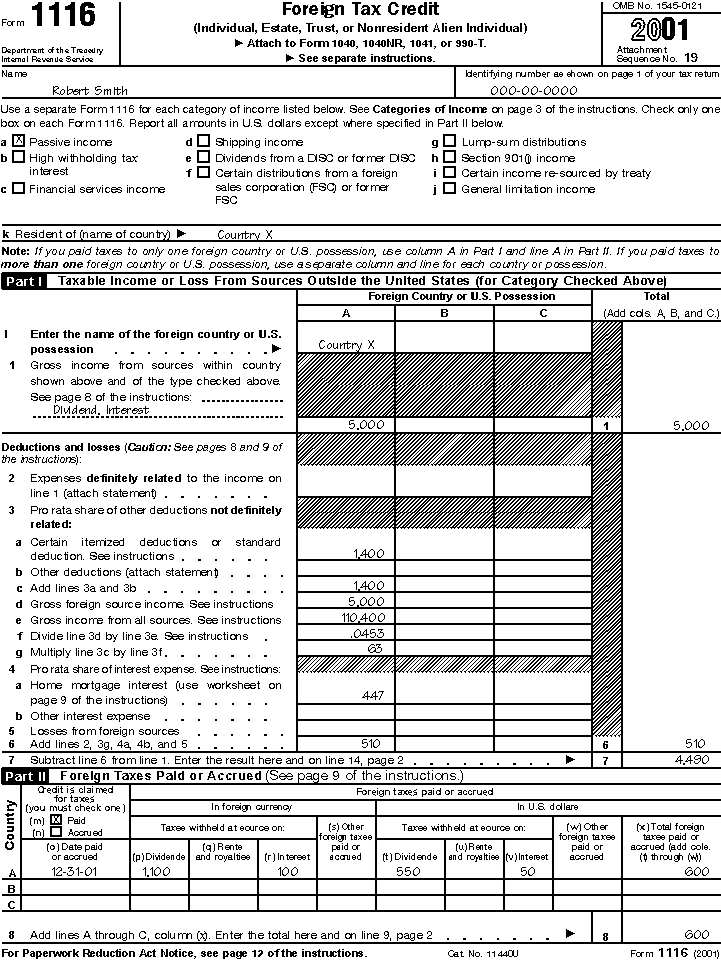 Form 1116, page 1 for Robert Smith
Form 1116, page 1 for Robert Smith
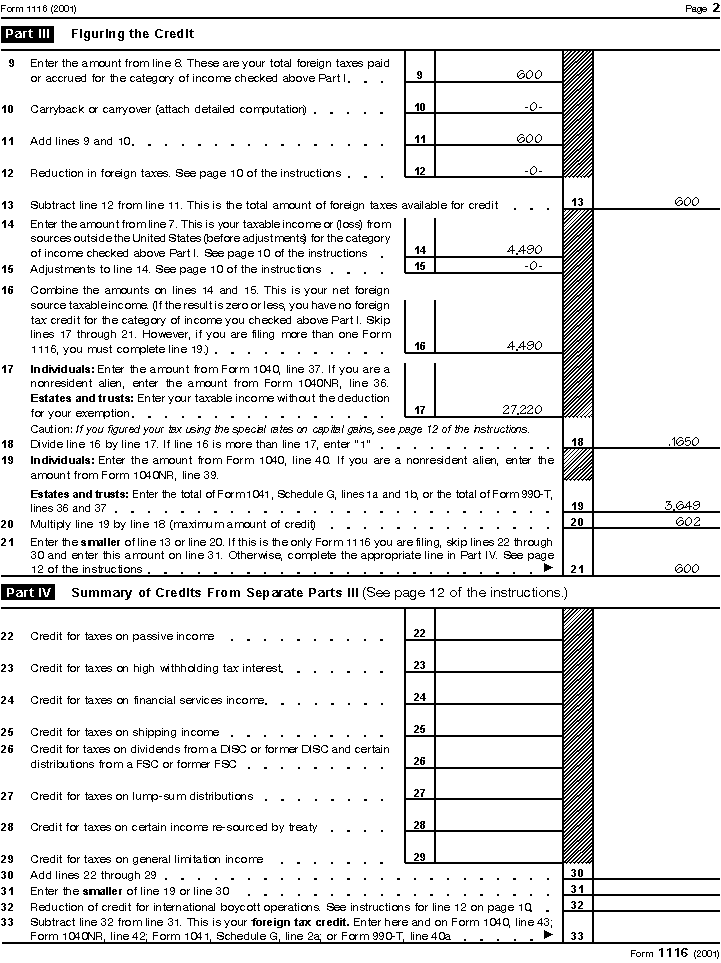 Form 1116, page 2 for Robert Smith
Form 1116, page 2 for Robert Smith
Unused Foreign Taxes
Robert now determines if he has any unused foreign taxes that can be used as a carryback or carryover to other tax years.
General limitation income. Robert has 2002 unused foreign taxes of $3,491 ($5,480 - $1,989) and $200 of 2001 unused foreign taxes available as a carryover to 2003 and later years. (The foreign taxes related to his foreign earned income exclusion are not available for carryover.) He cannot carry back any part of the 2002 unused taxes to 2000 or 2001 as shown in
Table 4.
Passive income. Since the tax Robert paid on his interest and dividend income is less than the amount for which he could have claimed a credit in 2002 under the limit for this separate income category, he has no unused tax and therefore no carryback or carryover to other tax years.
How To Get Tax Help
You can get help with unresolved tax issues, order free publications and forms, ask tax questions, and get more information from the IRS in several ways. By selecting the method that is best for you, you will have quick and easy access to tax help.
Contacting your Taxpayer Advocate. If you have attempted to deal with an IRS problem unsuccessfully, you should contact your Taxpayer Advocate.
The Taxpayer Advocate represents your interests and concerns within the IRS by protecting your rights and resolving problems that have not been fixed through normal channels. While Taxpayer Advocates cannot change the tax law or make a technical tax decision, they can clear up problems that resulted from previous contacts and ensure that your case is given a complete and impartial review.
To contact your Taxpayer Advocate:
- Call the Taxpayer Advocate at 1-877-777-4778.
- Call, write, or fax the Taxpayer Advocate office in your area.
- Call 1-800-829-4059 if you are a TTY/TDD user.
For more information, see Publication 1546,
The Taxpayer Advocate Service of the IRS.
Free tax services. To find out what services are available, get Publication 910,
Guide to Free Tax Services. It contains a list of free tax publications and an index of tax topics. It also describes other free tax information services, including tax education and assistance programs and a list of TeleTax topics.
 Personal computer.
Personal computer. With your personal computer and modem, you can access the IRS on the Internet at
www.irs.gov. While visiting our web site, you can:
- See answers to frequently asked tax questions or request help by e-mail.
- Download forms and publications or search for forms and publications by topic or keyword.
- Order IRS products on-line.
- View forms that may be filled in electronically, print the completed form, and then save the form for recordkeeping.
- View Internal Revenue Bulletins published in the last few years.
- Search Regulations and the Internal Revenue Code.
- Receive our electronic newsletters on hot tax issues and news.
- Learn about the benefits of filing electronically (IRS e-file).
- Get information on starting and operating a small business.
You can also reach us with your computer using File Transfer Protocol at
ftp.irs.gov.
 TaxFax Service.
TaxFax Service. Using the phone attached to your fax machine, you can receive forms and instructions by calling
703-368-9694. Follow the directions from the prompts. When you order forms, enter the catalog number for the form you need. The items you request will be faxed to you.
For help with transmission problems, call the FedWorld Help Desk at
703-487-4608.
 Phone.
Phone. Many services are available by phone.
- Ordering forms, instructions, and publications. Call 1-800-829-3676 to order current and prior year forms, instructions, and publications.
- Asking tax questions. Call the IRS with your tax questions at 1-800-829-1040.
- Solving problems. Take advantage of Everyday Tax Solutions service by calling your local IRS office to set up an in-person appointment at your convenience. Check your local directory assistance or www.irs.gov for the numbers.
- TTY/TDD equipment. If you have access to TTY/TDD equipment, call 1-800-829-4059 to ask tax questions or to order forms and publications.
- TeleTax topics. Call 1-800-829-4477 to listen to pre-recorded messages covering various tax topics.
Evaluating the quality of our telephone services. To ensure that IRS representatives give accurate, courteous, and professional answers, we use several methods to evaluate the quality of our telephone services. One method is for a second IRS representative to sometimes listen in on or record telephone calls. Another is to ask some callers to complete a short survey at the end of the call.
 Walk-in.
Walk-in. Many products and services are available on a walk-in basis.
- Products. You can walk in to many post offices, libraries, and IRS offices to pick up certain forms, instructions, and publications. Some IRS offices, libraries, grocery stores, copy centers, city and county governments, credit unions, and office supply stores have an extensive collection of products available to print from a CD-ROM or photocopy from reproducible proofs. Also, some IRS offices and libraries have the Internal Revenue Code, Regulations, Internal Revenue Bulletins, and Cumulative Bulletins available for research purposes.
- Services. You can walk in to your local IRS office to ask tax questions or get help with a tax problem. Now you can set up an appointment by calling your local IRS office number and, at the prompt, leaving a message requesting Everyday Tax Solutions help. A representative will call you back within 2 business days to schedule an in-person appointment at your convenience.
 Mail.
Mail. You can send your order for forms, instructions, and publications to the Distribution Center nearest to you and receive a response within 10 workdays after your request is received. Find the address that applies to your part of the country.
- Western part of U.S.:
Western Area Distribution Center
Rancho Cordova, CA 95743-0001
- Central part of U.S.:
Central Area Distribution Center
P.O. Box 8903
Bloomington, IL 61702-8903
- Eastern part of U.S. and foreign addresses:
Eastern Area Distribution Center
P.O. Box 85074
Richmond, VA 23261-5074
 CD-ROM for tax products.
CD-ROM for tax products. You can order IRS Publication 1796,
Federal Tax Products on CD-ROM, and obtain:
- Current tax forms, instructions, and publications.
- Prior-year tax forms and instructions.
- Popular tax forms that may be filled in electronically, printed out for submission, and saved for recordkeeping.
- Internal Revenue Bulletins.
The CD-ROM can be purchased from National Technical Information Service (NTIS) by calling
1-877-233-6767 or on the Internet at
http://www.irs.gov/cdorders. The first release is available in early January and the final release is available in late February.
 CD-ROM for small businesses.
CD-ROM for small businesses. IRS Publication 3207,
Small Business Resource Guide, is a must for every small business owner or any taxpayer about to start a business. This handy, interactive CD contains all the business tax forms, instructions and publications needed to successfully manage a business. In addition, the CD provides an abundance of other helpful information, such as how to prepare a business plan, finding financing for your business, and much more. The design of the CD makes finding information easy and quick and incorporates file formats and browsers that can be run on virtually any desktop or laptop computer.
It is available in March. You can get a free copy by calling
1-800-829-3676 or by visiting the website at
www.irs.gov/smallbiz.
Worksheet. Additional Foreign Tax Credit on U.S. income*
| I. U.S. tax on U.S. source income
|
COL. A
|
COL. B
|
|
|
(U.S. source rules)
|
|
|
|
1.
|
Dividends
|
|
|
|
|
|
2.
|
Interest
|
|
|
|
|
|
3.
|
Royalties
|
|
|
|
|
|
4.
|
Capital gain
|
|
|
|
|
|
5.
|
a.
|
Gross earned income
|
|
|
|
|
|
|
b.
|
Allocable employee business expenses
|
|
|
|
|
|
|
c.
|
Net compensation. Subtract line 5b from line 5a
|
|
|
|
|
|
6.
|
a.
|
Gross rent, real property
|
|
|
|
|
|
|
b.
|
Direct expenses
|
|
|
|
|
|
|
c.
|
Net rent. Subtract line 6b from line 6a
|
|
|
|
|
|
7.
|
Other
|
|
|
|
|
|
8.
|
Add lines 1-7 in columns A and B
|
|
|
|
|
|
9.
|
Enter tax from Form 1040 (see instructions)
|
|
|
|
|
10.
|
Enter adjusted gross income (AGI) from line 35, Form 1040
|
|
|
|
|
11.
|
Divide line 9 by line 10. Enter the result as a decimal. This is the average tax rate on your AGI.
|
|
|
|
|
12.
|
Multiply line 11 by line 8 (column B). This is your estimated U.S. tax on your U.S. source income.
|
|
| II. Tax at source allowable under treaty
|
|
|
|
|
A.
|
Items fully taxable by U.S.
|
|
|
|
|
|
13.
|
a.
|
Identify
|
|
|
|
|
|
|
b.
|
Multiply line 13a by line 11
|
|
|
|
B.
|
Items partly taxable by U.S.
|
|
|
|
14.
|
a.
|
Identify
|
|
|
|
|
|
|
b.
|
Treaty rate
|
|
|
|
|
|
|
c.
|
Allowable tax at source (Multiply line 14a by 14b)
|
|
|
|
|
15.
|
a.
|
Identify
|
|
|
|
|
|
|
b.
|
Treaty rate
|
|
|
|
|
|
|
c.
|
Allowable tax at source (Multiply line 15a by 15b)
|
|
|
|
|
16.
|
Total (Add line 13b, 14c, and 15c)
|
|
|
|
C.
|
Identify each item of U.S. source income from Col. A, Step I. on which the U.S. may not, under treaty, tax residents of the other country who are not U.S. citizens
|
|
|
|
|
|
|
|
|
|
|
|
|
|
|
| III. Additional credit
|
|
|
|
|
|
17.
|
Residence country tax on U.S. source income before foreign tax credit
|
|
|
|
|
18.
|
Foreign tax credit allowed by residence country for U.S. income tax paid
|
|
|
|
|
19.
|
Maximum credit. Subtract the greater of line 16 or line 18 from line 12.
|
|
|
|
|
20.
|
a.
|
Enter the amount from line 17
|
|
|
|
|
|
|
b.
|
Enter the greater of line 16 or line 18
|
|
|
|
|
|
|
c.
|
Subtract line 20b from line 20a
|
|
|
|
|
21.
|
Additional credit. Enter the smaller of line 19 or line 20c. Add this amount to line 33 of Part IV Form 1116.
|
|
| * See the discussion on Tax Treaties for information on when you should use this worksheet.
|
Worksheet Instructions. Additional Foreign Tax Credit on U.S. Income
|
|
| STEP I
|
| Figure the estimated tax on U.S. source income using U.S. source rules.
|
|
|
Lines 1-7 - Enter the gross amount for each type of income in Column A, and the net amount, if appropriate, in column B.
|
|
|
Line 9 - Enter the amount from Form 1040, line 42.
|
| STEP II
|
| Determine the amount of tax that the United States is allowed to collect at source under the treaty on income of residents of the other country who are not U.S. citizens.
|
|
|
PART A - Income fully taxable by the United States. Identify the type and amount on line 13a.
|
|
|
PART B - Income for which treaty limits U.S. tax at source.
|
|
|
Lines 14-15 - Identify each type and amount of income. Use the specified treaty rate. (See Publication 901, U.S. Tax Treaties.)
|
|
|
PART C - Identify the items not taxable at source by the United States under the treaty.
|
| STEP III
|
| Figure the amount of the additional credit for foreign taxes paid or accrued on U.S. source income. The additional credit is limited to the difference between the estimated U.S. tax (Step 1) and the greater of the allowable U.S. tax at source (Step II) or the foreign tax credit allowed by the residence country (line 18).
|
|
|
Line 17 - Enter the amount of the residence country tax on your U.S. source income before reduction for foreign tax credits. If possible, use the fraction of the pre-credit residence country tax which U.S. source taxable income bears to total taxable income. Otherwise, report that fraction of the pre-credit foreign tax which gross U.S. income bears to total gross income for foreign tax purposes.
|
|
|
Line 21 - This amount may be claimed as a foreign tax credit on Form 1116. Complete Form 1116 according to the instructions. Add the additional credit to line 33, Part IV, of Form 1116 and report that total on your Form 1040. File this worksheet with your Form 1040 as an attachment to Form 1116.
|
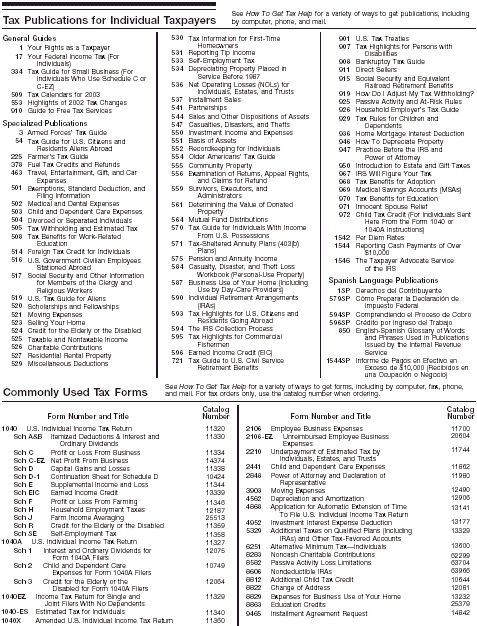
Previous | First
Publication Index | 2002 Tax Help Archives | Tax Help Archives | Home





 Personal computer. With your personal computer and modem, you can access the IRS on the Internet at www.irs.gov. While visiting our web site, you can:
Personal computer. With your personal computer and modem, you can access the IRS on the Internet at www.irs.gov. While visiting our web site, you can:
 TaxFax Service. Using the phone attached to your fax machine, you can receive forms and instructions by calling 703-368-9694. Follow the directions from the prompts. When you order forms, enter the catalog number for the form you need. The items you request will be faxed to you.
For help with transmission problems, call the FedWorld Help Desk at 703-487-4608.
TaxFax Service. Using the phone attached to your fax machine, you can receive forms and instructions by calling 703-368-9694. Follow the directions from the prompts. When you order forms, enter the catalog number for the form you need. The items you request will be faxed to you.
For help with transmission problems, call the FedWorld Help Desk at 703-487-4608.
 Phone. Many services are available by phone.
Phone. Many services are available by phone. Walk-in. Many products and services are available on a walk-in basis.
Walk-in. Many products and services are available on a walk-in basis.
 Mail. You can send your order for forms, instructions, and publications to the Distribution Center nearest to you and receive a response within 10 workdays after your request is received. Find the address that applies to your part of the country.
Mail. You can send your order for forms, instructions, and publications to the Distribution Center nearest to you and receive a response within 10 workdays after your request is received. Find the address that applies to your part of the country.
 CD-ROM for tax products. You can order IRS Publication 1796, Federal Tax Products on CD-ROM, and obtain:
CD-ROM for tax products. You can order IRS Publication 1796, Federal Tax Products on CD-ROM, and obtain: CD-ROM for small businesses. IRS Publication 3207, Small Business Resource Guide, is a must for every small business owner or any taxpayer about to start a business. This handy, interactive CD contains all the business tax forms, instructions and publications needed to successfully manage a business. In addition, the CD provides an abundance of other helpful information, such as how to prepare a business plan, finding financing for your business, and much more. The design of the CD makes finding information easy and quick and incorporates file formats and browsers that can be run on virtually any desktop or laptop computer.
It is available in March. You can get a free copy by calling 1-800-829-3676 or by visiting the website at www.irs.gov/smallbiz.
CD-ROM for small businesses. IRS Publication 3207, Small Business Resource Guide, is a must for every small business owner or any taxpayer about to start a business. This handy, interactive CD contains all the business tax forms, instructions and publications needed to successfully manage a business. In addition, the CD provides an abundance of other helpful information, such as how to prepare a business plan, finding financing for your business, and much more. The design of the CD makes finding information easy and quick and incorporates file formats and browsers that can be run on virtually any desktop or laptop computer.
It is available in March. You can get a free copy by calling 1-800-829-3676 or by visiting the website at www.irs.gov/smallbiz.
